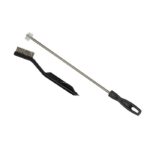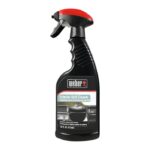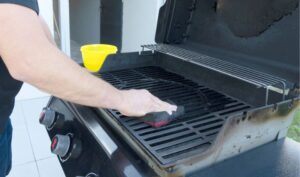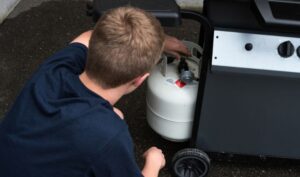Much like what you put on your grill, where you put your grill matters. The right grill placement doesn’t just make cooking easier—it’s essential for maximizing safety, performance, and convenience.
No matter what type of grill you’re using—gas, charcoal, pellet, or electric—there are important safety considerations to keep in mind when you’re deciding where to put your barbecue. Setting up your grill in the wrong spot can increase the risk of fires, carbon monoxide buildup, or damage to your home and yard. It can even violate local fire codes or condo rules.
In this guide, we’ll cover:
- General safety rules that apply to all types of grills
- Answers to common questions, like “What is a safe gas grill distance from my house?”, “Can I grill on my covered porch?”, and “How far should my grill be from a fence?”
- Specific placement tips for gas grills, charcoal grills, pellet grills, and electric grills
Let’s get cooking—safely.
General Safety Rules for All Grill Types and Frequently Asked Questions
When it comes to cooking with fire, there are some general safety rules that apply no matter what type of grill you have—gas, charcoal, pellet, or electric. Following these guidelines will help you grill confidently while protecting your home, your family, and your guests.
First and foremost:
- Never grill under low overhangs, balconies, enclosed patios, or inside a garage—even if doors and windows are open. Grilling indoors or under cover traps heat and gases like carbon monoxide, creating serious fire and health risks.
- Always set your grill on level ground to prevent tipping.
- Keep a safe distance. Your grill should be at least 10 feet away from your house, garage, fence, or other structures whenever it’s in use.
- Maintain a clear zone around your grill. Remove clutter, plants, patio furniture, or anything flammable. Make sure the area stays free of tripping hazards.
- Have a fire extinguisher nearby and ready to use. In case of a grease fire, turn off the grill and close the lid and vents to smother the flames. Remember: never use water on a grease fire. If needed, baking soda, sand, or salt can help extinguish it.
- Never leave your grill unattended, even for a few minutes.
- Regularly clean your grill to prevent grease buildup, a common cause of flare-ups and fires.
When setting up your grill, a few extra steps can make your grilling station even safer and more convenient:
- Use a grill deck mat or fireproof pad if you’re placing the grill on a deck or balcony to catch grease and protect surfaces.
- Install wind barriers or shields if you’re grilling in a breezy area to help maintain steady heat and prevent flare-ups.
- Add lighting if you plan to grill in the evening or after dark so that you can keep a close eye on your grill.
- Position your grill conveniently—not too far from your kitchen or prep area, but always respecting the required safety distance.
Shop for grill cleaning tools:
Frequently Asked Questions About Grill Placement
What is a safe gas grill distance from my house?
Grill manufacturers typically recommend keeping a minimum of three feet between a gas grill and your home.
However, for maximum safety, the U.S. Consumer Product Safety Commission advises placing your grill at least 10 feet away from any structure, including your house, garage, or shed. This helps prevent fire risks and reduces the chance of gas buildup or carbon monoxide infiltration, but these aren’t the only concerns with regards to proximity—at high temperatures, grills can produce enough radiant heat to warp siding, melt trim, scorch fences, or even start a fire if placed too close. Play it safe and keep a wide margin.
If you live in a condo or apartment, there may be additional rules you need to factor in regarding grill placement, or else you can be found liable for any damage. Double-check your condo rules and local fire codes before you settle on a grill placement.
Real-life reminder:
One backyard griller shared:
Comment
byu/soeunster from discussion
ingrilling
Moral of the story: It’s easy to underestimate how much heat your grill throws, especially if you step away even for a minute.
GRILL SPOT TIP: If your grill has wheels, you can store it closer to your house when it’s not in use—just roll it out 10 feet before firing it up.
How far should my grill be from a fence?
The same rule applies: at least 10 feet away from any structure, including fences, is ideal. Fences, especially wood or vinyl ones, can easily be damaged or catch fire from grill heat and flare-ups. Always position your grill to allow heat and smoke to dissipate freely.
What about grill placement on a deck?
Yes, you can grill on a deck—as long as you follow a few key safety steps:
- Your grill should still be at least 10 feet from your house, railings, and fences.
- Use a grill mat to protect your deck from grease splatters and food spills.
If you can satisfy these conditions, it’s safe to put your grill on your deck.
Real-life reminder:
One commenter warns:
Comment
byu/el_hombre_basura from discussion
ingrilling
Even a small flare-up can cause serious heat and fire damage to the structure above.
Charcoal grills, however, are riskier. Even with a grill mat, there’s always a chance that hot coals could spill or blow across the deck if the grill gets knocked over. If you have a wooden, vinyl, or composite deck, it’s safer to move a charcoal grill off the deck before lighting up.
Can I grill on my covered porch?
Technically, yes. But only if certain conditions are met.
Your covered porch must have:
- A ceiling height of at least 10 feet
- A non-combustible ceiling material (like stone or metal)
Otherwise, grilling under a covered porch is dangerous and often violates fire codes. Even if it’s worked for you before, or you have friends who have done this and gotten away with it, it only takes one incident to cause serious damage. Always check your local ordinances and building codes before grilling under any cover.
Can I grill in my garage?
No. You should never grill in your garage.
Grilling in a garage—even with the door open—is extremely dangerous. Carbon monoxide, gas buildup, and fire hazards make garages completely unsafe for any type of grilling.
Gas Grill Placement Safety Tips
Gas grills are one of the most popular ways to cook outdoors, but because they use pressurized propane or natural gas, proper placement is especially important for safety.
Here’s what you need to know:
- Place your gas grill on a stable, level surface like a patio, driveway, backyard, or deck.
- Ensure good ventilation. Never use a gas grill in enclosed spaces like garages, under low overhangs, or inside screened-in patios, even if windows are open.
- Follow the 10-foot rule. Keep your grill at least 10 feet away from your house, garage, railings, and fences. This distance reduces fire risks and helps prevent heat damage to your home’s siding, trim, or structures.
- Store propane tanks safely. Keep your propane tank outdoors, away from direct sunlight, heat sources, and anything that could ignite it. Never store a propane tank near air intakes like air conditioners, radiators, or furnace vents—leaking gas could seep into your home.
- Check local rules. If you live in a condo or apartment, verify building codes and HOA regulations before setting up your propane grill.
By following these guidelines for safe propane grill placement, you’ll reduce your fire risk, protect your home, and keep your cookouts worry-free.
Charcoal Grill Placement Safety Tips
Charcoal grills deliver rich, smoky flavor, but they also require extra caution when it comes to safe placement. You don’t have to worry about gas leaks, but open flames, hot embers, and carbon monoxide still pose real risks.
Here’s how to grill safely with charcoal:
- Grill only in well-ventilated outdoor spaces. Even without gas, charcoal grills still release carbon monoxide and smoke that need to dissipate safely.
- Avoid grilling near dry grass, mulch, or wood. Sparks or falling embers can easily ignite flammable surfaces.
- Be cautious about grilling on decks. If you’re using a charcoal grill on a deck, especially a wooden or vinyl one, use a grill mat to protect the surface—but even then, be aware that hot coals can scatter beyond the mat if the grill tips or gets bumped. For maximum safety, it’s best to move charcoal grills off decks and onto stone patios, concrete pads, gravel areas, or dirt surfaces.
- Keep a metal bucket handy for ash disposal. After grilling, allow the coals and ashes to cool completely before transferring them to a metal container with a tight-fitting lid.
- Never move a lit charcoal grill. Wait until all embers are fully extinguished and the grill is cool to the touch.
By taking extra care with charcoal grill placement, you’ll protect your deck, backyard, and home while still enjoying all the classic smoky flavor that charcoal grilling delivers.
Learn more about How To Set Up A Charcoal Grill.
Pellet Grill Placement Safety Tips
Pellet grills combine the flavor of wood smoking with the convenience of gas grilling, but they still require careful placement to ensure safe operation.
Here’s how to set up your pellet grill safely:
- Use your pellet grill only in well-ventilated outdoor areas. Pellet grills produce smoke and carbon monoxide, so proper airflow is critical.
- Keep your pellet grill at least 10 feet away from houses, garages, fences, and other structures. This helps protect against smoke damage, heat buildup, and fire risks.
- Position your grill away from doors and windows. Even if you’re grilling outdoors, smoke can drift into your home if the grill is too close to openings.
- Set up on safe surfaces like patios, concrete pads, gravel areas, or use a heatproof grill mat if grilling on a deck.
- Protect your hopper and electronics from moisture. Rain can damage the control panel, and wet pellets can jam the auger, so it’s a good idea to use a grill cover or position the grill in a sheltered but open-air location.
By following these pellet grill placement tips, you’ll protect your grill, maintain steady performance, and stay safe while enjoying low-and-slow smoking or high-heat searing.
Electric Grill Placement Safety Tips
Electric grills are a popular option for apartments, condos, and small outdoor spaces, but even though they don’t use open flames, they still come with important placement considerations.
Here’s how to grill safely with an electric grill:
- Always confirm building rules first. Many condos and apartment complexes allow electric grills, but some may still have restrictions. Check local regulations and HOA guidelines before setting up.
- Use indoor models only where permitted. Some electric grills are designed specifically for outdoor use, while others are safe for indoor kitchens. Only use indoor-approved grills inside; otherwise, stick to open-air spaces.
- Keep your electric grill dry. Avoid placing your grill on wet surfaces like soaked patios or grass. Use grounded outlets with GFCI protection (Ground Fault Circuit Interrupter) to reduce the risk of electrical shock.
- Manage your power cords carefully. Keep cords out of foot traffic areas to prevent tripping. Position cords away from the grill’s heat zones and other heat sources.
- Maintain the 10-foot rule whenever grilling outdoors. Even without an open flame, high temperatures and grease fires are still possible with electric grills.
By following smart electric grill placement practices, you’ll stay safe—and still enjoy great grilled flavor with a compact, convenient setup.
Safe Grill Placement Means Safer, Better Grilling
Where you place your grill matters just as much as how you cook on it. Following smart grill placement practices helps protect your home, your guests, and your grill, making every cookout easier and more enjoyable.
To recap the most important safety rules:
- Keep your grill at least 10 feet away from your house, garage, fences, and any other structures while in use.
- Never grill under low overhangs, balconies, enclosed patios, or in garages, even if windows and doors are open.
- Set your grill on stable, level ground to prevent tipping.
- Clear the area around your grill of clutter, plants, and anything flammable.
- Keep a fire extinguisher nearby and regularly clean your grill to reduce grease buildup.
Whether you’re setting up a gas grill, charcoal grill, pellet smoker, or electric model, a little extra attention to placement can make a big difference in safety and performance.
Want more grilling safety tips and maintenance advice? Check out our latest guides to keep your grill (and grilling) in top shape.







